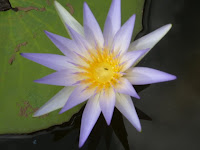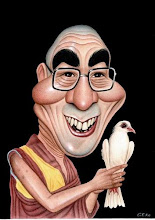
Three weeks have swiftly passed by in this spiritual refuge – after three weeks of just sitting and very little else, zazen (meditation) becomes a way of life. In the Buddhist tradition, meditation has been a core element of practice since the time of Shakyamuni Buddha, two thousand five hundred years ago. While all schools of Zen recognised zazen as the heart of their practice their approaches differ. The teachings of independent Zen Master, AMA Samy, of Bodhi Zendo embrace the two major Japanese Zen traditions - Soto and Rinzai. Soto approach to meditation is primarily shikantaza or “just sitting” while the Rinzai approach is centred on koans (existential, paradoxical questions such as ‘What is the sound of one hand clapping?’, ‘Does a dog has Buddha-Nature?’, ‘What was your original face before your parents were born?’ and so on). At this stage of my spiritual journey I do not think and am not convinced that the koan-based approach is appropriate for me and felt that shikantaza probably suits my present circumstances and temperament.
The specific practice experience of shikantaza was first articulated in the Soto Zen lineage by the Chinese Zen master Hongzhi Zhengjue (1091-1157), and further elaborated by the illustrious Japanese Soto founder Eihei Dogen (1200 – 1253) who also established Eiheiji, the eminent (even till today) Soto monastery renowned for its harsh training and discipline. While Hongzhi did not use the actual term, “just sitting”, his meditation teachings is usually referred to as “silent, or serene, illumination”. Hongzhi emphasised the necessity for balance between serenity and illumination, which echoed the traditional Buddhist meditation practice of shamantha-vipashyana or stopping and insight. He said, “If illumination neglects serenity then aggressiveness appears…..If serenity neglects illumination, murkiness leads to wasted dharma.” Hongzhi’s meditation values the balancing of both stopping, or settling the mind, and its active illuminating functioning. Another aspect of Hongzhi’s practice is that it is objectless not only in terms of letting go of concentration objects (as used in many Buddhist traditions), but also in the sense of avoiding any specific, limited goals or objectives. He wrote, “This serene illumination, or just sitting, is not a technique, or a means to some resulting higher state of consciousness, or any particular state of being. Just sitting, one simply meets the immediate present. Desiring some flashy experience, or anything more other than ‘this’ is mere worldly vanity or craving”. Eihei Dogen built on the teachings of Hongzhi and eventually made shikantaza his central practice and teaching. Dogen left behind numerous writings on how to practise and I would like to share with you a few of his legendary insights:
The Way is basically perfect and all-pervading. How could it be contingent upon practice and realisation? The Dharma vehicle is free and untrammelled. What need is there for concentrated effort? Indeed, the whole body is far beyond the world’s dust. Who could believe in a means to brush it clean? It is never apart from one, right where one is. What is the use of getting off here and there to practise? (From “Fukanzazengi)To study the Buddha Way is to study the self. To study the self is to forget the self. To forget the self is to be verified by all things .To be verified by all things is to let the body and mind of the self, and the body and mind of others, drop off. There is a trace of realisation that cannot be grasped. We endlessly keep expressing the ungraspable trace of realisation. (From “Genjokoan”)(As a consequence of this writing shikantaza is sometimes described as “just sitting and dropping off body and mind”.)
When Yaoshan was sitting in meditation, a monk asked, “What do you think about, sitting in steadfast composure?”Yaoshan said, “I think not-thinking.”The monk said, “How do you think not-thinking?”Yaoshan said, “Non-thinking.” (From “Shobogenzo”)The stage of non-thinking is beyond egocentric cognition. If you reach the state of non-thinking, you will realise the true luminous nature of mind. Non-thinking must become the eye through which you view phenomena. The activity of every buddha is based on non-thinking. (From “Zazenshin”) The last two writings above introduced the concept of non-thinking and distinguished between non-thinking and not-thinking. John Daido Loori, the abbot of Zen Mountain Monastery in New York, comments:
“Abide in neither thinking nor not-thinking. Thinking is linear and sequential, a separation from the reality that is the subject of thought, and thus is an abstraction rather than reality itself. Not-thinking is suppressive. It cuts away thoughts the moment they arise, making the mind into a great impenetrable mountain – dead, unresponsive. Non-thinking has no such edges. It is the bondless mind of samadhi that neither holds on to, nor let’s go of, thoughts. It is the manifestation of the buddha-mind in which the dualism of self and other, thinking and not thinking, dissolves.”Daido further adds:
“Shikantaza is meditation without a goal. It is boundless – a process that is continually unfolding………..It is zazen based fundamentally on faith – faith in the Buddha’s enlightenment, faith in one’s buddha nature, faith in the process of practice itself……… When you are doing shikantaza you don’t try to focus on anything specifically , or to make thoughts go away. You simply allow everything to be just the way it is. Thoughts come, thoughts go, and you simply watch them, you keep your awareness on them. It takes a lot of energy and persistence to sit shikantaza, to not get caught in daydreaming. But little by little, thoughts begin to slow down, and finally they cease to arise. When the thought disappears, the thinker disappears. This is the samadhi of falling away of body and mind.”And he finally urges:
“Please take up this practice of zazen (i.e. shikantaza). You don’t need any special props to do it. You don’t need complex instructions or monasteries and teachers. You just need a quiet corner to settle your body, settle your mind and taste your breath. Then just let the breath breathe itself. Think of non-thinking. This is the dharma of thusness that is the right thought of all the buddhas in the ten thousand directions. It is Shakyamuni’s realisation at the moment of his enlightenment: all sentient beings are perfect and complete, lacking nothing. You are perfect and complete, lacking nothing. Trust that. Trust the process of zazen. If you were to live for a hundred thousand years, you would never find in this life anything more powerful, more healing, more empowering, than the simple practice of zazen. Please don’t take it lightly. It’s an incredible gift.” “May your journey be fruitful and may your life go well.”
John Daido Loori


















